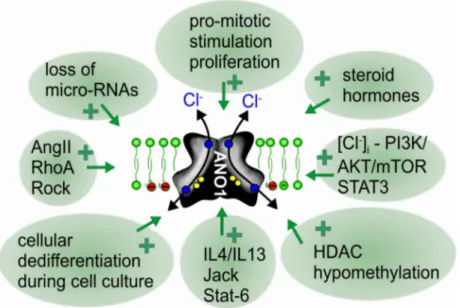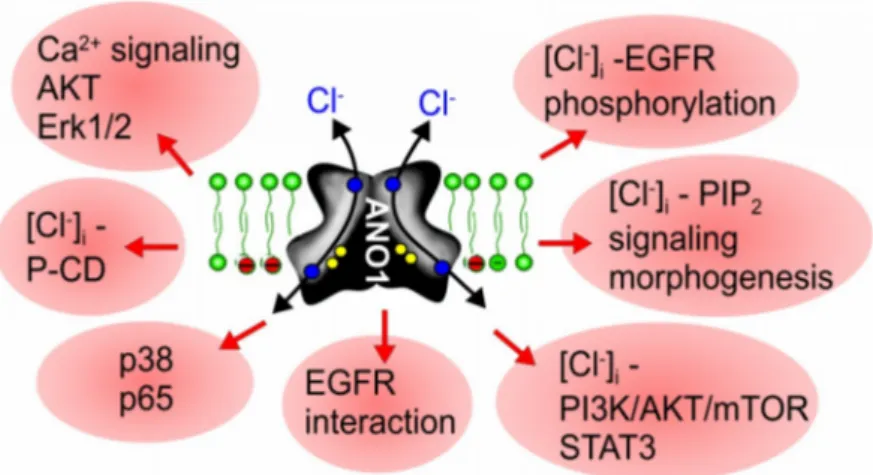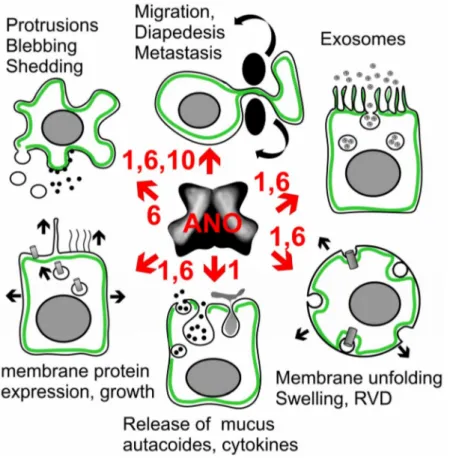Review
Contribution of Anoctamins to Cell Survival and Cell Death
Karl Kunzelmann * , Jiraporn Ousingsawat, Roberta Benedetto, Ines Cabrita and Rainer Schreiber
Institut für Physiologie, Universität Regensburg, Universitätsstraße 31, D-93053 Regensburg, Germany;
Jiraporn.Ousingsawat@vkl.uni-regensburg.de (J.O.); Roberta.Benedetto@vkl.uni-regensburg.de (R.B.);
Ines.Cabrita@vkl.uni-regensburg.de (I.C.); Rainer.Schreiber@vkl.uni-regensburg.de (R.S.)
* Correspondence: Karl.kunzelmann@ur.de; Tel.: +49-941-943-4302; Fax: +49-941-943-4315
Received: 19 February 2019; Accepted: 16 March 2019; Published: 19 March 2019
Abstract: Before anoctamins (TMEM16 proteins) were identified as a family of Ca
2+-activated chloride channels and phospholipid scramblases, the founding member anoctamin 1 (ANO1, TMEM16A) was known as DOG1, a marker protein for gastrointestinal stromal tumors (GIST). Meanwhile, ANO1 has been examined in more detail, and the role of ANO1 in cell proliferation and the development of different types of malignomas is now well established. While ANO5, ANO7, and ANO9 may also be relevant for growth of cancers, evidence has been provided for a role of ANO6 (TMEM16F) in regulated cell death. The cellular mechanisms by which anoctamins control cell proliferation and cell death, respectively, are just emerging; however, the pronounced effects of anoctamins on intracellular Ca
2+levels are likely to play a significant role. Recent results suggest that some anoctamins control membrane exocytosis by setting Ca
2+ilevels near the plasma membrane, and/or by controlling the intracellular Cl
−concentration. Exocytosis and increased membrane trafficking induced by ANO1 and ANO6 may enhance membrane expression of other chloride channels, such as CFTR and volume activated chloride channels (VRAC). Notably, ANO6-induced phospholipid scrambling with exposure of phosphatidylserine is pivotal for the sheddase function of disintegrin and metalloproteinase (ADAM). This may support cell death and tumorigenic activity of IL-6 by inducing IL-6 trans-signaling. The reported anticancer effects of the anthelminthic drug niclosamide are probably related to the potent inhibitory effect on ANO1, apart from inducing cell cycle arrest through the Let-7d/CDC34 axis. On the contrary, pronounced activation of ANO6 due to a large increase in intracellular calcium, activation of phospholipase A2 or lipid peroxidation, can lead to ferroptotic death of cancer cells. It therefore appears reasonable to search for both inhibitors and potent activators of TMEM16 in order to interfere with cancer growth and metastasis.
Keywords: anoctamin; ANO1; ANO6; TMEM16A; TMEM16F; cancer; proliferation; apoptosis; Ca
2+signaling; inflammation
1. Introduction
Cl
−currents activated by an increase in intracellular Ca
2+(CaCC) have been known for more than 40 years. The human homologue of Drosophila tweety and the bestrophin family of channels were shown to operate as Ca
2+activated Cl
−channels (reviewed in [1–3]). However, they behave differently from the “classical” receptor-operated CaCC, identified 11 years ago as anoctamin 1 (ANO1; TMEM16A) [4–6]. ANO1 is particularly expressed in acinar cells of secretory glands and is regulated by CLCA1 [7,8]. Apart from glands, CaCCs have long been known to be present primarily in proliferating cells in culture and various types of cancer cells [9–11]. After identification of ANO1 as Ca
2+activated Cl
−channel, it became clear that the protein is identical to DOG1, a significant and
Cancers2019,11, 382; doi:10.3390/cancers11030382 www.mdpi.com/journal/cancers






